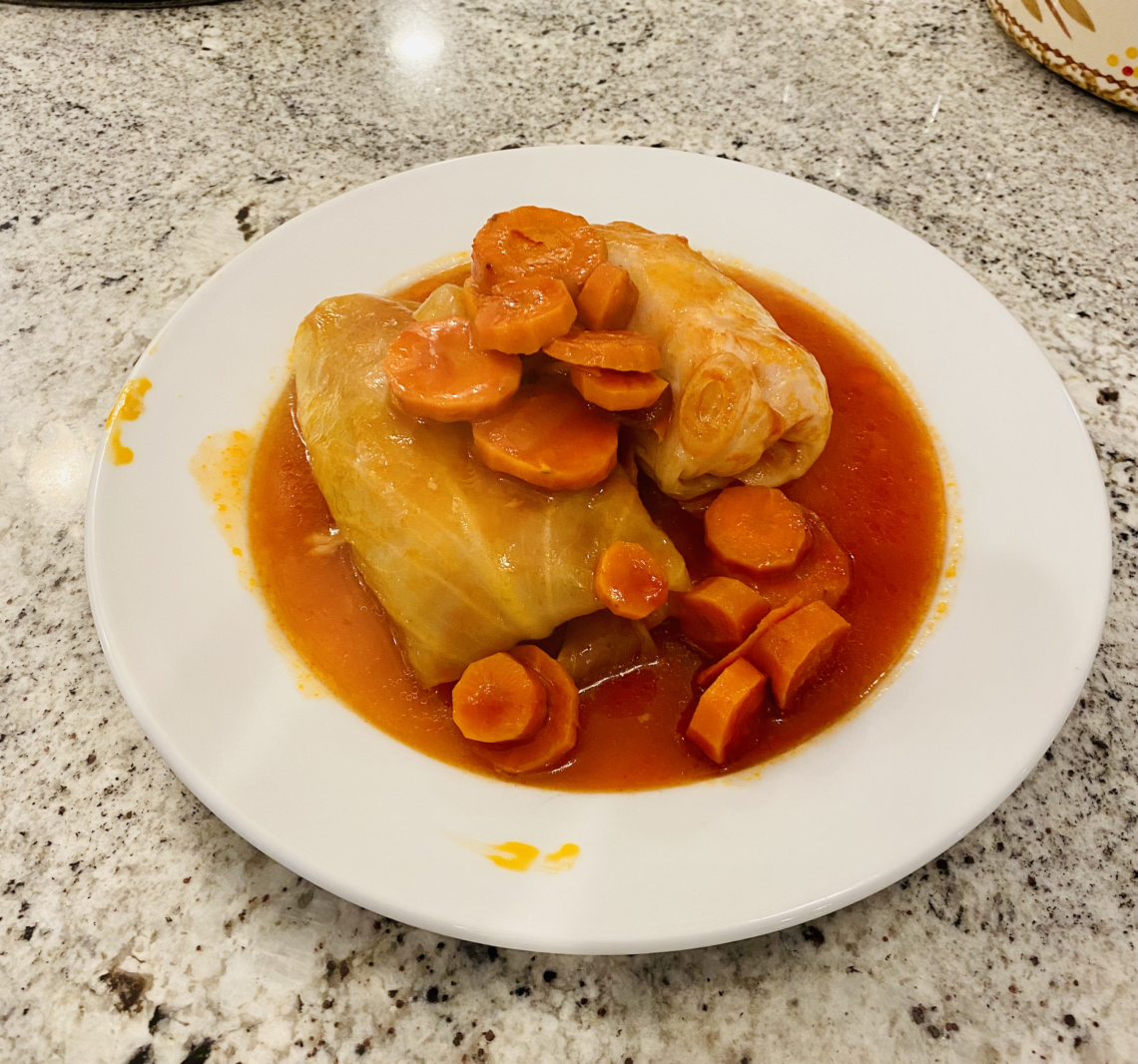
A Bit of Québécois Heritage Food: Cigares au Chou
The Story
The undisputed favorite heritage dish in my household isn’t even remotely French, but it comes from Mom’s family, and so I include it in this section.
I like to make up the provenance here, that my grandmaman lived next to an old Polish woman at some point in her life and got the opportunity to watch her make galumpkies out of ingredients she already had, was inspired and delighted and ran home to make it for her mess of eight children and demanding husband. It became her staple, she won church cooking contests, and with her winnings bought her signature red lipstick.
But, no. Cigares au chou, a dish I have since learned is made all around the world, just appeared in our family menu and I have no idea why. My grandparents ran a series of businesses, including a restaurant/post office combo, and maybe it was there that they started doing it. Or it came from the Paquin side of the family. Regardless, there is no other dish more comforting to me in the world, and in spite of its rather laborious process I’ll make it whenever I’m given the opportunity.
Of course it has V8 juice. All good recipes from Mom’s family have V8 in them. Cheap, salty, and flavorful, it bolstered even the most meagre meat into something more. I’m lucky that we made it through the 70s without jellied aspic disasters or fondue nightmares, so I’ll take it.
Cigares au chou is a great cold-weather climate food, not just because it warms you up beautifully but because it makes use of cold-weather vegetables, namely carrots, onions, and cabbage. When half the year is smothered in snow it’s important to be able to use veggies on the low end of perishable. My great-grandmother Rose had one of the most impressive basement larders I’d ever seen; shelves upon shelves of pickles, jams and jellies, preserves, and storage. My mother owns the house now, and it still has a dirt basement. Maybe one of these days I’ll restore it to its former glory… plus some okra pickles.
The components of cigares au chou, or “cabbage cigars” as translated, are simple: ground beef and rice rolled in cabbage and cooked in tomato sauce, carrots, and onions. Though I’d be excommunicated if I didn’t mention the crowning achievement of the dish: salt pork. You forget the salt pork and the whole meal falls flat.
Mom often made cigares au chou for her brothers and sisters when they came to the States with his family. So I feel like I’m bringing a bit of Canada here to me. But beware, there’s a lot of boiling involved.
And making cigares au chou in a hurry is a dangerous feat, at least the way Mom prepares it. The first challenge is getting the leaves off the head of cabbage and supple enough that you can roll them around the meat and rice. Mom’s approach was always cutting around the center part and then boiling it until the leave started to peel off one by one.
One year she used the huge lobster pot that my godparents had given us for our yearly lobster boils, and when she lifted the lid in haste managed to give herself second degree burns all up and down her arm. I’m fairly certain that she ended up still making dinner that night, because that’s how she rolls. But that’s mom for you. She might hate cooking, but once she starts, she’s all in.
When it comes to cigares au chou, some of my relatives love to tell me how much they don’t like it. I beg to differ. It is so, so good. The balance of acid and fat, of savory and sweet, it’s unparalleled. In the fall, it’s not pumpkin spice I get excited about, it’s the cigares au chou.
The Recipe
A few important notes. The selection of the head of cabbage itself is incredibly important. You need a heavy, big-leafed cabbage, and those aren’t usually plentiful, at least around here, until early fall. It’s got to hold up to the boiling, which is really the best way for leaf extraction. You essentially make little cabbage burritos in this application, and while I’ve tried variety of ways to remove the leaves one at a time from the head — including microwaving — I just can’t get a consistent roll out of anything else other than boiling.
To take the leaves off one at a time, you cut around the stem with a knife. Like so many steps in this process it’s absolutely treacherous. If you’ve ever try to cut into a huge, raw head of cabbage, you know what I’m talking about. If you can manage to saw around the stem, though, and submerge it in boiling water, you can pull the leaves off one at a time. Don’t use a fork. Use tongs.
I like mixing the ground beef with things other than par boiled white rice, but if you’re looking for true authenticity, don’t bother with the quinoa and brown rice mix I use. Similarly, you’ll want to stick with the Hormel salt pork my mom uses, not my hippy dippy local fat back (it doesn’t change the flavor, really, but it does cut back on the salt). But I will say this: without the V8, it just doesn’t taste the same.
The skill comes in making the little cigares. You turn the leaf facing you, as if it’s growing from the stem. Cut out the hard bit with a knife in a triangular slice. Then put about two ounces of rice and raw beef in a line at the base. Take the bottom and roll once, then capture the sides and roll forward. You’ll be able to tuck it in perfectly, and it’ll look like a sweet little happy package of goodness.
Make enough of these to fill the bottom of a casserole dish. Cover with sliced carrots and onions, place the fat back or salt pork in four places — north, south, east, and west — and then any extra in the very middle. Then drown with the V8 juice.
Here are my approximate measurements.
Cigares au Chou (Cabbage Cigars)
Makes about 12-14 cigares.
1 large head of cabbage, 12+ leaves removed.
2 lbs ground beef
2 cups of white rice, brown rice, or quinoa
Salt and pepper
2 medium onions, sliced
12 medium carrots, sliced
5 slices salt pork/fat back
Combine rice with raw beef, add salt and pepper. Roll mixture in cabbage leaves. Cover with remaining ingredients. Cooking 375 degree oven for 2 hours, covered. Serve immediately — traditionally my family uses over-boiled potatoes, but I prefer a roasted medley of sweet potatoes and regular potatoes.





